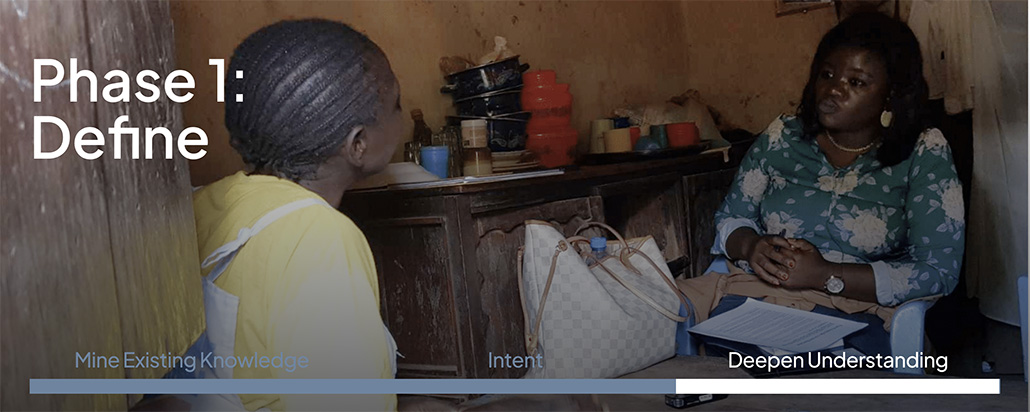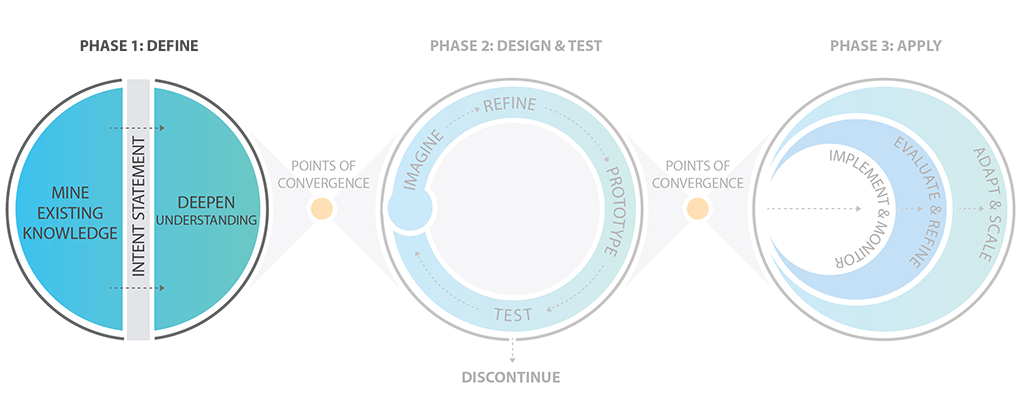Deepen Understanding

Democratic Republic of the Congo, Define
The Define Phase establishes the foundational understanding of the challenge from two perspectives: (1) existing knowledge and published literature, and (2) new, shared knowledge of lived experiences in households, communities, health systems, and political environments. It provides the opportunity to immerse oneself into the world in which people live and to design better solutions. This phase also provides an opportunity for key stakeholders to align with shared intent for the activity or project objective, building relationships and buy-in from the outset.

Deepen Understanding
How can we learn even more?
By the end of this step, your team will have a different perspective of the challenge to be addressed and will have built empathy for those you are designing with by filling gaps that arose during the mine existing knowledge and intent steps.
How to conduct this step and achieve its main objectives:
Conduct Immersive Research
Immersive research puts you in the heart of the action, offering unique perspectives often missed from a distance. This approach not only widens the frame but allows you to inhabit the space where lives and interactions unfold, fostering empathy and shaping your creative work.
Immersive Research Package
Suggested time:
Multiple days depending on size and scope
Participants:
Design and research team, partners and
stakeholders, individuals you are designing for
Tool: Conducting Immersive Research Package
The immersive research package is a comprehensive resource containing a research protocol framework, a suite of methodological tools, and data collection templates. These materials are crafted to provide support to researchers in their studies. The templates, being adaptable to various contexts, promote in-depth exploration and understanding of the needs of the people you are designing for.
Effort required:

Synthesize the Data
Synthesis allows you to take the data you collected during your research and organize it into themes by distilling and clustering findings. You can use empathy tools like journey maps or personas to summarize the data while remembering the human element of the people with whom we are working.
Root Cause Analysis
Suggested time:
3–4 hours
Participants:
Design and research team
Tool: Root Cause Analysis
A root cause analysis is a process used to identify the primary source of a problem. In social and behavior change, a root cause analysis is used to examine why there is a difference between the desired state of a health or social issue (vision) and what is happening now (current situation).
Effort required:

Behavioral Journey Map Template
Suggested time:
5–6 hours
Participants:
Design and research team
Tool: Behavioral Journey Map Template
A behavioral journey map is a visual representation employed for the analysis and comprehension of an individual’s actions, emotions, and experiences within a particular process or interaction. It delineates significant touch points, emotional states, and pain points, offering valuable insights for researchers and designers into user behavior.
Effort required:

Generate Insights
The collection of new data provides so much to learn. Analyzing the discovery findings, in conjunction with the existing knowledge, leads you to potential levers for change, or insights around which your programs will be designed. An insight is a significant shift in perspective that helps to uncover unthought-of opportunities. Insights connect information and inspiration in new ways to see a situation in an unexpected way.
Behavioral Insights Template
Suggested time:
3–4 hours
Participants:
Design and research team
Tool: Behavioral Insights Template
Generating insights is an intensive, rapid, and creative process. It starts with the raw data (e.g., observations, notes, stories, quotes, and images) from the research, generating themes and connections, which lead to opportunities that inspire the next phase in the process. Use this template to develop your insights.
Effort required:

Insights 101 Playbook
Suggested time:
2–4 hours
Participants:
Design and research team
Tool: Insights 101 Playbook
Insights are the distillation of the formative research, that allows you to include the research findings in the design. The Insights Playbook is an introductory guide to one of the key building blocks of SBC project design: Insights. The playbook offers concise and practical guidelines with examples – from identifying insights to applying and sharing them across project partners.
Effort required:

